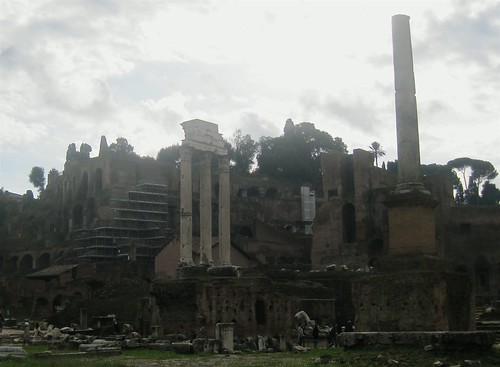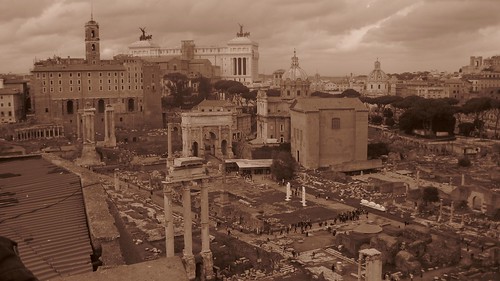The way up from the Forum takes visitors through the renaissance gardens of the Farnese family. Historians argue whether their landscaping adequately pays tribute to the early history of the Roman hillside or disrespects the later work of the Empire. Such real estate saw many redevelopments as the property changed hands. In my opinion, the gardens and villas pay adequate homage to the spirit of the much admired address.
The top of the hill provides the best views down to the Forum. From here you cans see all three victory arches and even as far as the Colosseum. From this perspective, you can imagine what the site would have looked like in antiquity. With the building plans laid out below, it takes just a little imagination to project the lives of the senators, priests and priestesses working to keep the public institutions of the Empire in motion.
Further on, past the gardens and to the opposite slope, visitors encounter the remains of the oldest and most sacred sites on the hill. Here researchers have uncovered Romulean Huts from the very beginnings of recorded history. Digesting all of the information and keeping all the sites in chronologic order becomes too much in one afternoon, however. At this point, I began selectively jumping to only the most visually interesting audio points.
 Without doubt, the most impressive and important structure on the hill belonged to the Cesar. Although Augustus constructed a modest residence on the hill (using his own money no less), the Domus Flavia palace was the real trend setter. This sprawling mega-plex included beautiful baths, numerous residential suites, executive offices, a Nymphaeum (you wouldn’t want your playful virgin demi-goddesses to go homeless) and a private hippodrome. An ego driven construction to be sure, it was also necessary as full control of the State was placed under executive control. The major mechanisms of government would now be fulfilled on the Palatine Hill.
Without doubt, the most impressive and important structure on the hill belonged to the Cesar. Although Augustus constructed a modest residence on the hill (using his own money no less), the Domus Flavia palace was the real trend setter. This sprawling mega-plex included beautiful baths, numerous residential suites, executive offices, a Nymphaeum (you wouldn’t want your playful virgin demi-goddesses to go homeless) and a private hippodrome. An ego driven construction to be sure, it was also necessary as full control of the State was placed under executive control. The major mechanisms of government would now be fulfilled on the Palatine Hill.Four hours and a couple thousand years of history and still I had not seen the ultimate symbol of Roman power. The Colosseum was up next.


![Reblog this post [with Zemanta]](http://img.zemanta.com/reblog_e.png?x-id=76d0a326-2507-4038-9759-6d4943542212)

No comments:
Post a Comment